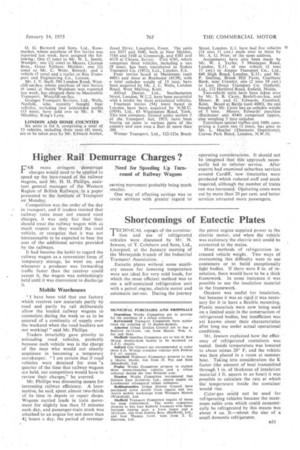Shortcomings of Eutectic Plates
Page 71

If you've noticed an error in this article please click here to report it so we can fix it.
'TECHNICAL aspegts of the construe
tion and use of refrigerated vehicles were discussed by Mr. N. Jewson, of T. Coleborn and Sons, Ltd., Liverpool, at the January meeting of the Merseyside branch of the Industrial Transport Association.
Eutectic plates without some auxiliary means for lowering temperature were not ideal for very cold loads, for which the most efficient method was to use a self-contained refrigeration unit with a petrol engine, electric motor and automatic cut-out. During the journey the petrol engine supplied power to the electric motor, and when the vehicle was stationary the electric unit could be connected to the mains.
Wrist methods of refrigeration increased vehicle weight. Two ways of overcoming this difficulty were to use containers or to build exceptionally light bodies. If there were 8.in. of •insulation, there would have to be a thick framework. In some instances it was possible to use the insulation material in the framework.
Onazote was useful for insulation, but because it was so rigid it was necessary for it to have a flexible mounting. Plastic materials were now being used on a limited scale in the construction of refrigerated bodies, but insufficient was yet known about their characteristics after long use under actual operational conditions.
Mr. Jewson explained how the efficiency of refrigerated containers was tested. Inside temperature was lowered to about minus 20° F, and the vehicle was then placed in a room at summer heat. Taking into consideration the K factor (the amount of heat transmitted through 1 in. of thickness of insulation material I ft. square in an hour) it was possible to calculate the rate at which the temperature inside the container would rise. _
Calor-gas could not be used for refrigerating vehicles because the maximum cubic area which could economically be refrigerated by this means was about 4 cu. ft.—about the size of a small domestic refrigerator.
















































































































